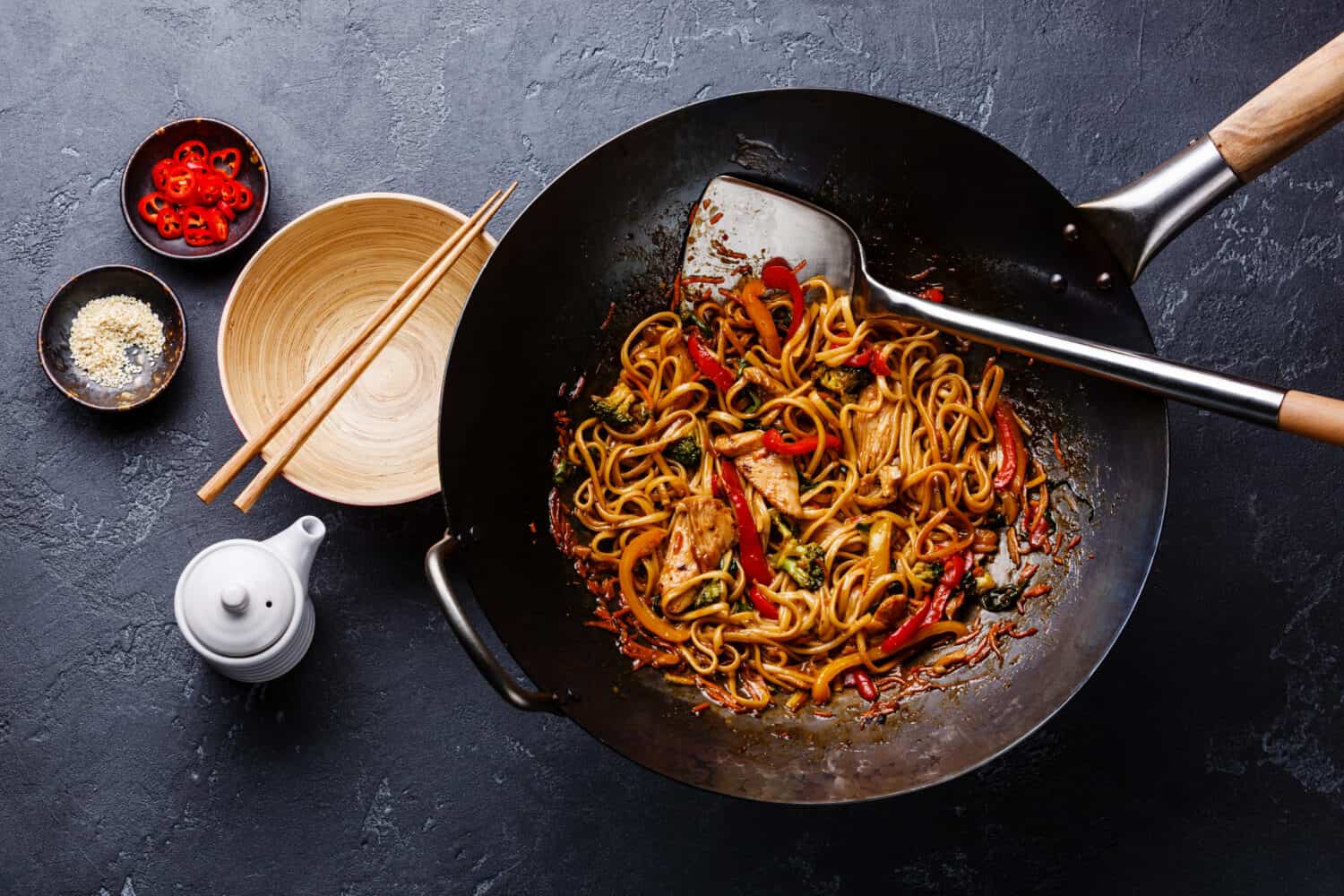In the arena of savory noodle preparations, there are no losers when choosing between pan-fried noodles and lo mein noodles. The two culinary contenders differ in how they prepare the noodles and the types of noodles they use. They sometimes call pan-fried noodles chow mein noodles, but they attach the pan-fried name to the cooking technique used, not necessarily to the type of noodles used.
- The must-have convenient reference guide for every home cook!
- Includes more than 8,000 substitutions for ingredients, cookware, and techniques.
- Save time and money on by avoiding trips to grab that "missing" ingredient you don't really need.
Pan-Fried Noodles vs. Lo Mein: What Are the Differences?
Lo mein noodles are some of the most iconic in Asian-American fusion cuisine. According to cookbook author Maggie Zsu, these fat, chewy noodles came to the States with Cantonese immigrants. They contain flour (usually wheat flour), water, and egg. Manufacturers extrude the dough into long, thin noodles. Cooks then boil them until they reach tenderness, coat them in a sauce, and toss them with eggs, vegetables, mushrooms, meat, and bean sprouts.
To make pan-fried noodles, you cook chow mein noodles using a slightly different method. To pan fry your noodles, cook the noodles to al dente and then transfer them to a pan with hot oil to finish them. The result should be a noodle that has a crisp, chewy exterior and a tender, soft middle.
They take similar times to cook, depending on the brand that you use. Lo mein noodles are thicker, but not so much so that they don’t work well as a weeknight option. And you can pair both types of noodles (and cooking techniques) with any combination of sauces, vegetables, and proteins that sound delicious.
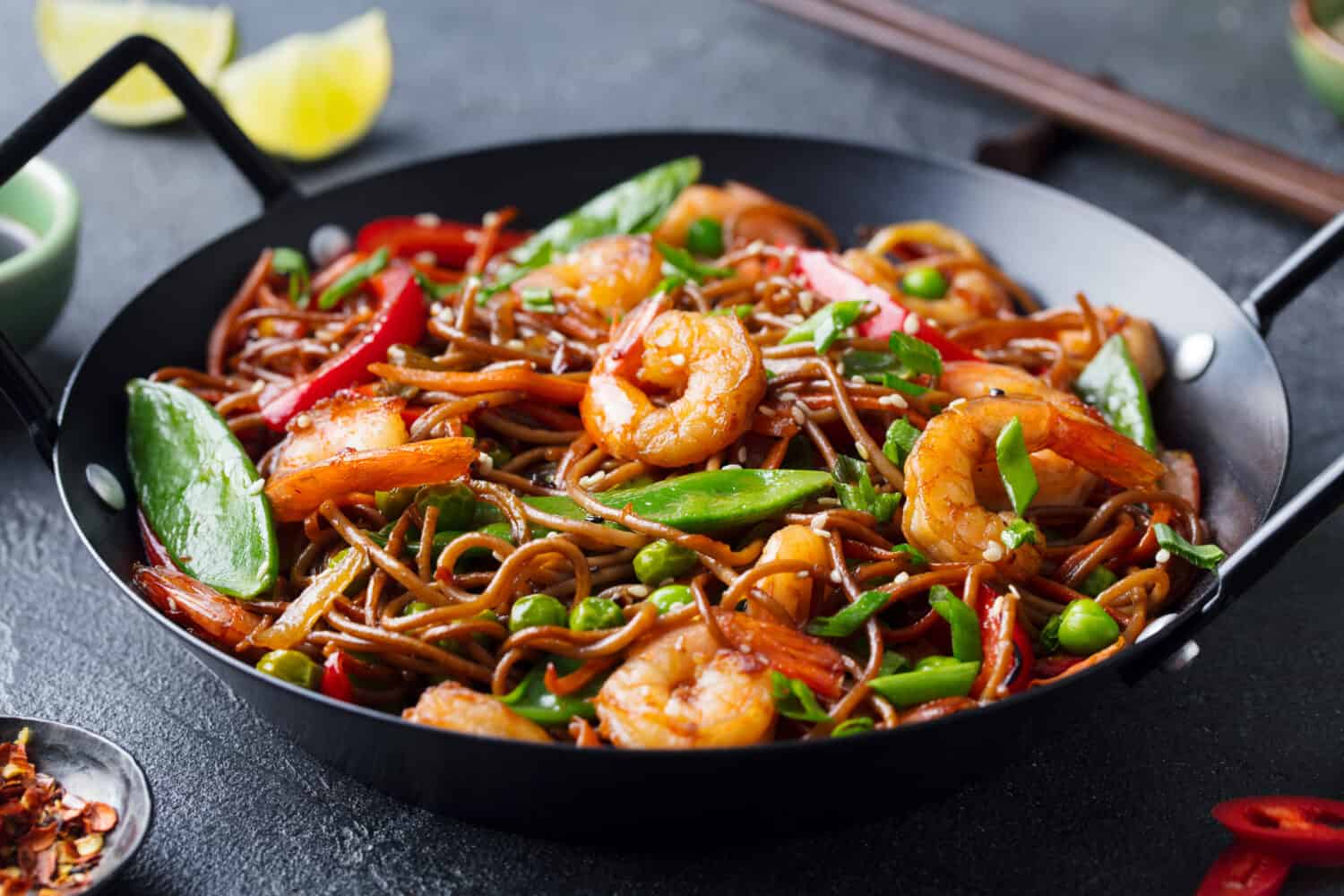
©Anna_Pustynnikova/Shutterstock.com
Pan-Fried vs. Lo Mein: Nutritional Value
As is always the case if you deep fry something, it takes a hit nutritionally. In this case, the nutrition of pan-fried noodles adjusts to consider the added fat of the frying oil. Both lo mein and chow mein have similar nutritional profiles. You can make either kind of dish healthier if you load it up with different delicious veggies and proteins.
Can You Substitute Pan-Fried Noodles for Lo Mein?
You can use either type of noodle – or ramen if you prefer – to make a pan-fried noodle bowl. Chow mein is the most common choice for pan-fried noodles. But there are no hard and fast rules saying you can’t use any noodle variety and simply pan-fry them.
Lo mein noodles, however, are what they are – for a dish to be lo mein, you have to use a lo mein noodle. Cook them to the desired chewy texture and toss them with meats, eggs, veggies, and sauce of your choosing.
Are Pan-Fried Noodles and Lo Mein the Same Thing?
To achieve a crispy and chewy texture, you should par-cook noodles in boiling water and finish cooking them in a wok with hot oil. To achieve a crispy and chewy texture, you should par-cook noodles in boiling water and finish cooking them in a wok with hot oil. This is the method for making pan-fried noodles and is unique among other Cantonese noodle dishes.
On the other hand, boil your lo mein noodles until they are tender. Then simply mix in with sauce, steamed or sauteed vegetables. Finish by adding a protein of your choice such as shrimp, chicken, pork, or beef.
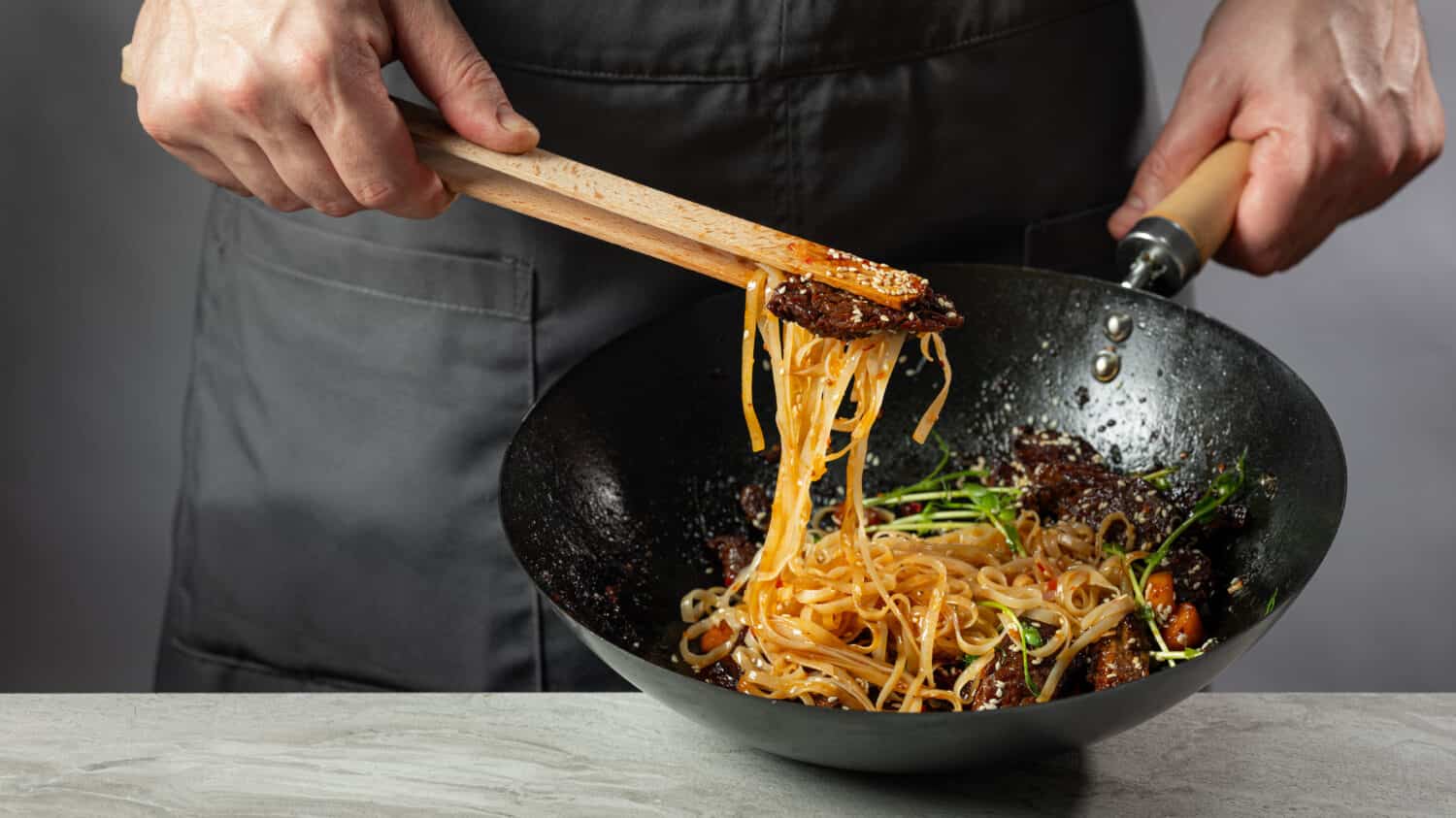
©Anton Chernov/Shutterstock.com
What Are the Best Substitutions for Pan-Fried Noodles?
You can swap any noodle variety in for chow mein to make pan-fried noodles at home. You’ll be playing a little fast and loose with the authenticity of the dish, but let’s be real here: if it’s time to get your family fed in between school and a practice/dance class/scouts meeting, we aren’t breaking a sweat over stealthily slipping ramen, spaghetti, or udon in here.
When cooking thicker noodles, you must adjust your cooking times between boiling and frying. However, the difference is only minutes, so even the thickest noodles can be a good substitute for chow mein. It's perfect for those feeling adventurous or using whatever they have in the pantry. Here's our primer on Lo Mein vs. Chow Mein, which includes nutrition and substitution recommendations.
The trickier swap-in will be using a thinner noodle, and that’s simply because they overcook much faster and have less mass to them. It’s hard, for example, to use glass noodles and achieve both crispy and chewy using this cooking method. This is because the noodles are too thin to support both textures at once.
What Are the Best Substitutions for Lo Mein?
If you’re looking to make a truly delicious lo mein recipe at home, you can achieve consistent results by swapping in noodles of similar thickness while keeping your sauce and veggie add-ins the same. Spaghetti, soba noodles (a little heartier but still delicious), Pad Thai noodles, fettuccine, and other long, medium-thick noodle varieties will all work.
- The must-have convenient reference guide for every home cook!
- Includes more than 8,000 substitutions for ingredients, cookware, and techniques.
- Save time and money on by avoiding trips to grab that "missing" ingredient you don't really need.
A Quick Comparison of Pan-fried Noodles and Lo Mein
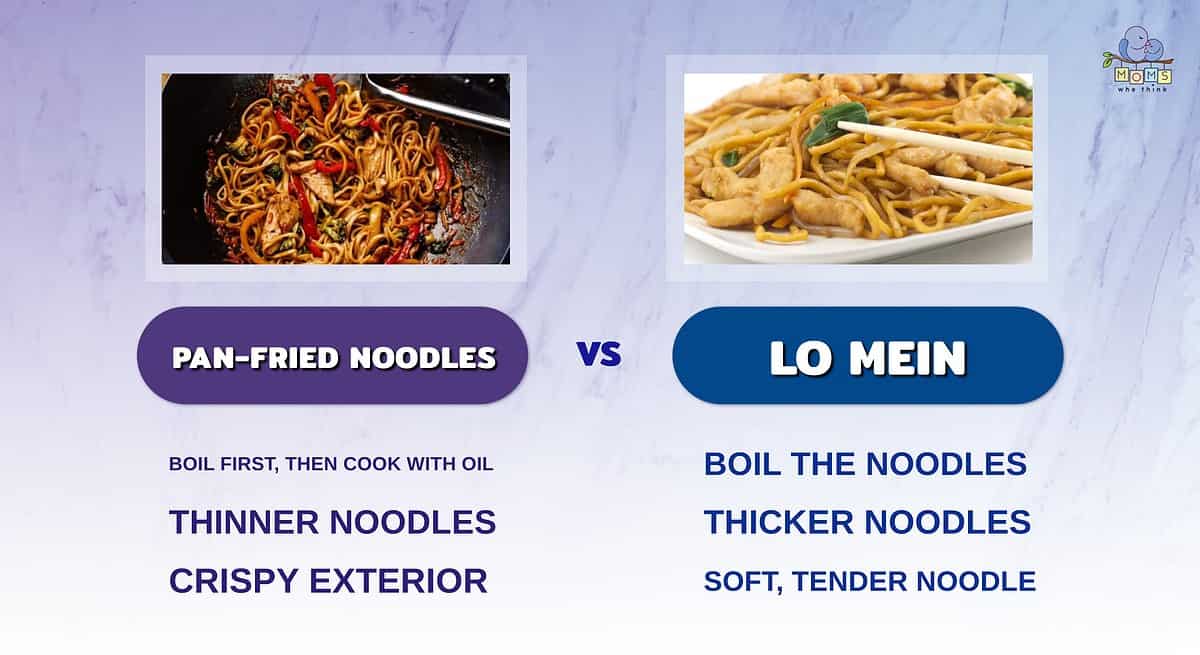
Pan-fried noodles is less a specific type of noodle and more of a way that noodles are cooked. The noodles are first boiled, and then finished in a wok with oil. This differs from the way that lo mein is cooked; the noodles in this dish are boiled and then tossed with sauce before serving. The noodles used in lo mein are thicker, allowing them to attract the sauces used. Pan-frying noodles will give them a crispy exterior, contrasting the all-around tenderness of lo mein. Both of these dishes are worth trying if you haven't already, whether from your local Chinese restaurant or made at home.
Best Lo Mein Recipes
Best Pan-Fried Noodle Recipes
- 10-Minute Pan Fried Noodles (Cookerru)
- Hong-Kong Style Pan Fried Noodles (Serious Eats)
- Noodles vs. Spaghetti
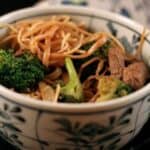
Beef Broccoli Lo Mein
- Yield: 6 servings 1x
Ingredients
- 8 ounces uncooked spaghetti
- 1 teaspoon dark sesame oil
- 1 tablespoon peanut oil
- 1 tablespoon minced peeled fresh ginger
- 4 cloves garlic, minced
- 3 cups chopped broccoli
- 1 1/2 cups vertically sliced onion
- 1 (1 pound) flank steak, trimmed and cut across grain into long thin strips
- 3 tablespoons low-sodium soy sauce
- 2 tablespoons brown sugar
- 1 tablespoon oyster sauce
- 1 tablespoon chile paste with garlic
Instructions
- Cook pasta according to package directions, omitting salt and fat; drain. Combine pasta and sesame seed oil, tossing well to coat.
- While pasta cooks, heat peanut oil in a large nonstick skillet over medium-high heat. Add ginger and garlic, sauté 30 seconds. Add broccoli and onion; sauté 3 minutes. Add steak; sauté 5 minutes or until done. Add pasta mixture, soy sauce, and remaining ingredients; cook 1 minutes or until lo mein is thoroughly heated, stirring constantly.
Nutrition
- Serving Size: 1⅓ cups
- Calories: 327
- Sodium: 382mg
- Fat: 9.3g
- Saturated Fat: 3g
- Carbohydrates: 39.1g
- Fiber: 2.9g
- Protein: 21.7g
- Cholesterol: 36mg
The image featured at the top of this post is ©Natalia Lisovskaya/Shutterstock.com.
